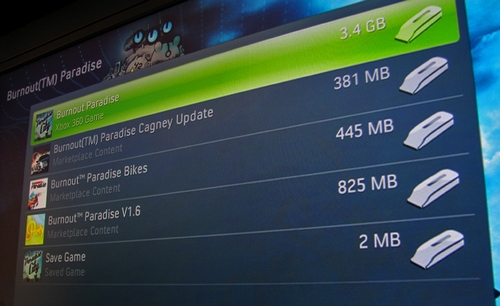The Price of Progress Part 1: Capacity

We may be about in the middle of the current generation of consoles, but unlike years past when graphical finesse was the only thing improving, innovation continues forward in the invisible, intangible online corners of our systems. Over a series of upcoming posts I plan to talk about the evolving online space and hopefully put some concerns and suggestions into the collective consciousness for the betterment of the next generation. If this were a professionaly published article I’d have quotes from experts and sidebars full of facts, but since I’m without resources (and time and money and contacts) we’ll just treat this like an opinion piece. So please jump in with your own thoughts, this is by no means a doctrine of any kind.
For now let’s skip the whole concept of digital marketplaces and go right to the content itself because that’s what I’ve been thinking about a lot lately. At the end of the download we’re as close to physically possessing the content as possible. It’s the point where price, data size, and the experience of using the content feel most like a traditional, physical product and the place where things are starting to get out of hand.
Most publishers today are content with an initial release — be it retail or digital — and a follow-up expansion along with a couple brand-extending themes and a free bug-squashing title update or two. The big exception to that trend right now is Criterion Studios and their 2008 racer, Burnout Paradise. Over the first year of release the team has pushed out several title updates, new vehicles, a free download that significantly changes the gameplay experience, and their first paid content that adds a whole offline multiplayer mode. They’re not slowing down in 2009 either with even more new vehicles on the way, a time saving cheat download, more game-changing play modes, and an entirely new island with races and challenges of its own.
I’m all for it from the gameplay side of things. Changing and sculpting a game, largely for free, years after its release marks a revolution in gaming from development through marketing and all the way down to us end users. Developers are listening to their fans and for the first time in console history they have the means to improve and refine their games after they’ve been released. New features and content keep the game in the public eye longer than ever before and the opportunity is there to make a profit on the business end from sales and continued in-game advertising. The price for this particular progress, however, is capacity. Let’s do a little breakdown and see how much space all of the available content takes up.

| Game Install (from disc on 360 or purchase on PS3) | 3.4gb |
| Bogart Title Update | approx. 2mb |
| Cagney Title Update | 381mb |
| Bikes Pack | 445mb |
| 1.7 Title Update | 872mb |
| Party Pack (data added in 1.7) | — |
| Time Saver (data added in 1.7) | — |
| Legendary Cars (data added in 1.7) | — |
So one year of keeping Burnout Paradise relevant and updated takes just about 5 gigabytes of hard drive space. Even without the install it’s still nearly 2 gigs and this doesn’t factor in the two announced car packs, the Cops & Robbers mode which will include new vehicles of its own, and the massive Big Surf Island expansion. Hardcore fans can take it even farther and carve out another 71 megs of space for the numerous themes and gamerpics that Criterion has released. It also doesn’t help that V1.7 includes both the Cagney update and Bikes pack which creates redundant data that’s just sitting on your hard drive until someone tells you it’s okay to remove. By 2010 the full (and possibly fragmented) Burnout Paradise experience could easily top 8 or 9 gigabytes.
This isn’t a problem for most players today. The most basic PlayStation 3 and the majority of Xbox 360’s have three to four times that much space with models going up to 60, 80, and 120 gigabytes. It’d be worth mentioning the poor Xbox 360 Arcade model whose built in memory isn’t enough to enjoy even half of Burnout Paradise, but it’s a simple step to buy a hard drive to bring it up to par. Nope, a few swollen games today isn’t going to kill anyone, but what about tomorrow?
That’s the tomorrow that could be anywhere from one to three years from now as we get to the end of this generation of consoles. One 7gb game isn’t a problem, but it’s obvious that Criterion has put some long legs on Burnout Paradise and other publishers are sure to want in on that kind of return. How many of these “extended games” can our consoles support alongside weekly downloadable releases that can peak in the 700mb range, a slew of demos, video rental services, and music game add-ons?
I’m thrilled to see consoles expanding into digital distribution at such a rapid pace, I’m just wondering when we’ll hit critical mass and have to pay out for 250 or even 500gb drives. And where to from there? If it’s 500gb this generation do we start out with a terabyte next round? And maybe the biggest questions of all; can we take our digital libraries with us and will the DRM that lets us play today ever shut down?
That’s more than enough for this first installment. I’ve got two pages of notes and we’ve only just started. Up next is the literal price of progress; micropayments and how quickly they add up.












